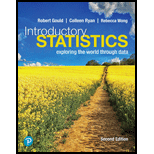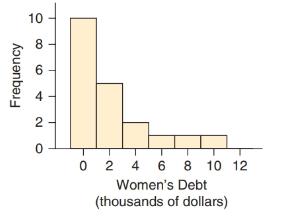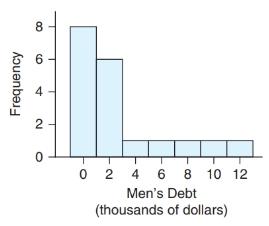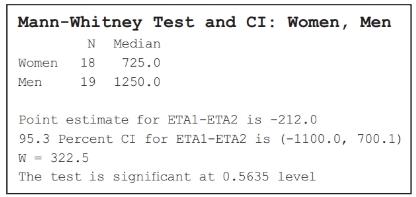
Credit Card Debt A statistics student who was interested in credit card debt asked a random sample of students for the total amount of their credit card debt. We eliminated the two women and the one man who had a debt of 0, which left 18 women and 19 men.


a. By looking at the histograms of the data, determine whether it would be appropriate to do a two-sample t-test using this data set. Explain.
b. Refer to the Minitab output. Which group had a higher
c. Refer to the Minitab output provided to test whether the typical credit card debt (as measured by the median) is different for men and women, using a significance level of 0.05.

Want to see the full answer?
Check out a sample textbook solution
Chapter 13 Solutions
INTRODUCTORY STATISTICS (LOOSELEAF)
Additional Math Textbook Solutions
Beginning and Intermediate Algebra
Elementary & Intermediate Algebra
Precalculus
Elementary and Intermediate Algebra: Concepts and Applications (7th Edition)
Elementary Statistics ( 3rd International Edition ) Isbn:9781260092561
Intermediate Algebra (13th Edition)
- WHAT IS THE CORRECT ANSWER AND WHY?arrow_forwardA common way for two people to settle a frivolous dispute is to play a game of rock-paper-scissors. In this game, each person simultaneously displays a hand signal to indicate a rock, a piece of paper, or a pair of scissors. Rock beats scissors, scissors beats paper, and paper beats rock. If both players select the same hand signal, the game results in a tie. Two roommates, roommate A and roommate B, are expecting company and are arguing over who should have to wash the dishes before the company arrives. Roommate A suggests a game of rock-paper-scissors to settle the dispute. Consider the game of rock-paper-scissors to be an experiment. In the long run, roommate A chooses rock 21% of the time, and roommate B chooses rock 61% of the time; roommate A selects paper 39% of the time, and roommate B selects paper 21% of the time; roommate A chooses scissors 40% of the time, and roommate B chooses scissors 18% of the time. (These choices are made randomly and independently of each…arrow_forwardA qualifying exam for a graduate school program has a math section and a verbal section. Students receive a score of 1, 2, or 3 on each section. Define X as a student’s score on the math section and Y as a student’s score on the verbal section. Test scores vary according to the following bivariate probability distribution. y 1 2 3 1 0.22 0.33 0.05 x 2 0.00 0.08 0.20 3 0.07 0.05 0.00 μXX = , and μYY = σXX = , and σYY = The covariance of X and Y is . The coefficient of correlation is . The variables X and Y independent. The expected value of X + Y is , and the variance of X + Y is . To be accepted to a particular graduate school program, a student must have a combined score of 4 on the qualifying exam. What is the probability that a randomly selected exam taker qualifies for the program? 0.45 0.47 0.46 0.33 Chebysheff’s Theorem states that the…arrow_forward
- what is the correct answer and why?arrow_forward(a) How many bit strings of length 10 both begin with a 1 and end with 2 zeroes? (b) How many permutations of the letters PQRSTUV contain PRS and QV?arrow_forward(d) A clothing store sells red, white, green, orange and pink charms for a specialty bracelet. How many ways can a customer purchase a bracelet with (i) 16 charms? (ii) 27 charms with at least 3 of each colour?arrow_forward
- (d) Draw the Venn diagram which represents the set (A U B) U (B NC).arrow_forwardThe ages of undergraduate students at two universities (one in the east and one in the west) are being compared. Researchers want to know if there is a difference in the mean age of students at the two universities. The population standard deviations are known. The following data shows the results of samples collected at each institution: School Location n sample mean population std. dev. West 33 26.78 6.29 East 35 23.16 7.52 What is the value of the test statistic for this problem? what is the p-value? what is the decision (reject or do not reject the null hypothesis?arrow_forwardA common way for two people to settle a frivolous dispute is to play a game of rock-paper-scissors. In this game, each person simultaneously displays a hand signal to indicate a rock, a piece of paper, or a pair of scissors. Rock beats scissors, scissors beats paper, and paper beats rock. If both players select the same hand signal, the game results in a tie. Two roommates, roommate A and roommate B, are expecting company and are arguing over who should have to wash the dishes before the company arrives. Roommate A suggests a game of rock-paper-scissors to settle the dispute. Consider the game of rock-paper-scissors to be an experiment. In the long run, roommate A chooses rock 24% of the time, and roommate B chooses rock 85% of the time; roommate A selects paper 12% of the time, and roommate B selects paper 14% of the time; roommate A chooses scissors 64% of the time, and roommate B chooses scissors 1% of the time. (These choices are made randomly and independently of each…arrow_forward
- Perform the following hypothesis test: HO: µ = 6 H1: µ 6 The sample mean is 5.6, sample standard deviation of 1.5 and a sample size of 42. Use a 5% significance level. Need to answer the following questions: what is the value of the test statistic? what is the p-value for this test (round to 3 decimal places)? what is the decision (reject the null hypothesis or do not reject the null hypothesis)?arrow_forwardPerform the following hypothesis test of a proportion: HO: p = 0.125 HA: p 0.125 The sample proportion is 0.2 based on a sample size of 95. Use a 10% significance level. need to solve the following questions: what is the value of the test statistic? what is the p-value? what is the decision (reject the null hypothesis or do not reject the null hypothesis)?arrow_forwardOOOOOOO00 Let's play Pick-A-Ball with replacement! There are 10 colored balls: 2 red, 4 white, and 4 blue. The balls have been placed into a small bucket, and the bucket has been shaken thoroughly. You will be asked to reach into the bucket, without looking, and select two balls. Since the bucket has been shaken thoroughly, you can assume that each individual ball is selected at random with equal likelihood of being chosen. Now, close your eyes! Reach into the bucket, and pick a ball. (Click the red Pick-A-Ball! icon to select your ball.) Pick-A-Ball! What is the probability of selecting the color of ball that you just selected? (Enter your answer in decimal format and round it to two decimal places.) Assume you have put your first ball back into the bucket. Now, reach in (again, no peeking!), and pick your second ball. (Click the red Pick-A-Ball! icon to select your second ball.) Pick-A-Ball! What is the probability of selecting the color of ball that you just selected? (Enter your…arrow_forward
 Big Ideas Math A Bridge To Success Algebra 1: Stu...AlgebraISBN:9781680331141Author:HOUGHTON MIFFLIN HARCOURTPublisher:Houghton Mifflin Harcourt
Big Ideas Math A Bridge To Success Algebra 1: Stu...AlgebraISBN:9781680331141Author:HOUGHTON MIFFLIN HARCOURTPublisher:Houghton Mifflin Harcourt Holt Mcdougal Larson Pre-algebra: Student Edition...AlgebraISBN:9780547587776Author:HOLT MCDOUGALPublisher:HOLT MCDOUGAL
Holt Mcdougal Larson Pre-algebra: Student Edition...AlgebraISBN:9780547587776Author:HOLT MCDOUGALPublisher:HOLT MCDOUGAL Glencoe Algebra 1, Student Edition, 9780079039897...AlgebraISBN:9780079039897Author:CarterPublisher:McGraw Hill
Glencoe Algebra 1, Student Edition, 9780079039897...AlgebraISBN:9780079039897Author:CarterPublisher:McGraw Hill College Algebra (MindTap Course List)AlgebraISBN:9781305652231Author:R. David Gustafson, Jeff HughesPublisher:Cengage Learning
College Algebra (MindTap Course List)AlgebraISBN:9781305652231Author:R. David Gustafson, Jeff HughesPublisher:Cengage Learning




